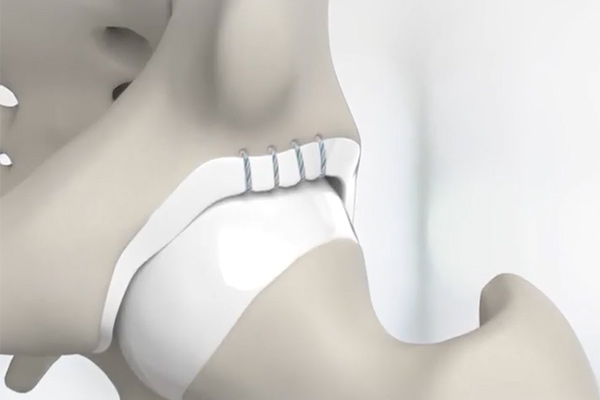Labral Reconstruction

At AHIRF, we have played a key role in advancing the science of labral reconstruction in hip arthroscopy. Through focused research and innovation, we’ve helped define when and how reconstruction should be performed, and its impact on outcomes. Our work highlights the importance of restoring labral function when native tissue is deficient, to support joint stability, biomechanics, and long-term success. These efforts continue to shape surgical decision-making and improve care for patients with complex labral pathology.

Research Highlights
- Outcomes After Anatomic Labral Repair With All-Suture Knotless Tensionable Anchors in Primary Hip Arthroscopic Surgery: A Prospective Analysis of 200 Consecutive Patients
- Return to Sports and Minimum 2-Year Outcomes of Primary Arthroscopic Hip Labral Reconstruction for Irreparable Tears in High-Level Athletes: A Propensity-Matched Controlled Study
- The Beveled Rim Technique for Labral Reconstruction
- Circumferential Labral Reconstruction for Irreparable Labral Tears in the Primary Setting: Minimum 2-Year Outcomes With a Nested Matched-Pair Labral Repair Control Group
- Long-Term Outcomes of Arthroscopic Labral Treatment of Femoroacetabular Impingement in Adolescents: A Nested Propensity-Matched Analysis
Search Our Publications by Topic
- Revision Hip Labral Reconstruction after Primary Repair Demonstrates Inferior Outcomes Compared to Matched Primary Reconstruction at Minimum 2-Year Follow-Up
- Durable Outcomes After Hip Labral Reconstruction at Minimum 5-Year Follow-Up: A Systematic Review
- Minimum 5-Year Outcomes After Primary Segmental Labral Reconstruction for Irreparable Labral Tears in the Hip With Hamstring Grafts: With a Subanalysis Comparing Autograft Versus Allograft
- Revision Hip Arthroscopy With Labral Reconstruction for Irreparable Labral Tears in Athletes: Minimum 2-Year Outcomes With a Benchmark Control Group
- Minimum 2-Year Outcomes Following Arthroscopic Hip Labral Reconstruction in Adolescents and Young Adults
- Comparable Minimum 2-Year Patient-Reported Outcome Scores Between Circumferential and Segmental Labral Reconstruction for the Management of Irreparable Labral Tear and Femoroacetabular Impingement Syndrome in the Primary Setting: A Propensity-Matched Study
- Minimum 5-Year Outcomes of Arthroscopic Hip Labral Reconstruction With Nested Matched-Pair Benchmarking: A Multi-Center Analysis
- After Revision Hip Arthroscopy, Patients Having Either Circumferential or Segmental Labral Reconstructions Demonstrate Favorable Outcomes: A Retrospective Review
- It’s Not Arthritis! Resolution of the Illusion of Joint Space Narrowing with Acetabuloplasty and Labral Reconstruction for the Calcified Labrum
- Return to Sports and Minimum 2-Year Outcomes of Primary Arthroscopic Hip Labral Reconstruction for Irreparable Tears in High-Level Athletes: A Propensity-Matched Controlled Study
- Return to Sport and Athletic Function in an Active Population After Primary Arthroscopic Labral Reconstruction of the Hip: A Prospective Cohort Study
- Primary Hip Arthroscopic Surgery With Labral Reconstruction: Is There a Difference Between an Autograft and Allograft?
- Arthroscopic Reconstruction of the Irreparable Acetabular Labrum: A Match-Controlled Study
- Arthroscopic Reconstruction of Segmental Defects of the Hip Labrum: Results in 22 Patients With Mean 2-Year Follow-Up
- The Beveled Rim Technique for Labral Reconstruction
- Circumferential Labral Reconstruction With Knotless All-Suture Anchors Restores Hip Distractive Stability: A Cadaveric Biomechanical Analysis
- Circumferential and Segmental Arthroscopic Labral Reconstruction of the Hip Utilizing the Knotless Pull-Through Technique with All-Suture Anchors
- Circumferential and Segmental Labral Reconstruction: A Systematic Review
- Hip Labral Augmentation With Tibialis Anterior Tendon Allograft Using the Knotless Pull-Through Technique
- Arthroscopic Labral Reconstruction of the Hip Using Semitendinosus Allograft
- Arthroscopic Labral Reconstruction of the Hip Using Local Capsular Autograft
- Arthroscopic Triple Reconstruction in the Hip Joint: Indications, Techniques, and Early Outcomes
- Graft Options in Hip Labral Reconstruction: A Systematic Review
- Arthroscopic Labral Reconstruction Is Superior to Segmental Resection for Irreparable Labral Tears in the Hip
- Endoscopic Shelf Procedure and Ischiofemoral Decompression with Arthroscopic Acetabular Labral Reconstruction: A Case Report
- Acetabular Labral Reconstruction Does Not Demonstrate Superior Biomechanical Properties Compared to Labral Repair or Intact Native Labrum but Is Superior to Labral Excision: A Systematic Review of Cadaveric Studies
- Letter to the Editor Regarding "Comparison of Suction Seal and Contact Pressures Between 270° Labral Reconstruction, Labral Repair, and the Intact Labrum"
- Letter to the Editor Regarding "Comparison of Suction Seal and Contact Pressures Between Labral Reconstruction and Repair"
- Circumferential Labral Reconstruction With Knotless All-Suture Anchors Restores Hip Distractive Stability: A Cadaveric Biomechanical Analysis
- Restoration of Labral Function in Primary Hip Arthroscopy: From Labral Repair to Labral Reconstruction
- Decision Making for Labral Treatment in the Hip: Repair Versus Débridement Versus Reconstruction
- Is Labral Size Predictive of Failure With Repair in Hip Arthroscopy?
- Radiographic and Demographic Factors Can Predict the Need for Primary Labral Reconstruction in Patients Undergoing Hip Arthroscopy
- Hip Labral Reconstruction: Consensus Study on Indications, Graft Type and Technique among High-Volume Surgeons
- Primary Labral Reconstruction in Patients with Femoroacetabular Impingement, Irreparable Labral Tears, and Severe Acetabular Chondral Defects Decreases the Risk of Conversion to Total Hip Arthroplasty: A Pair-Matched Study
- Circumferential Labral Reconstruction for Irreparable Labral Tears in the Primary Setting: Minimum 2-Year Outcomes With a Nested Matched-Pair Labral Repair Control Group
- In Search of Labral Restoration Function with Hip Arthroscopy: Outcomes of Hip Labral Reconstruction vs. Labral Repair
